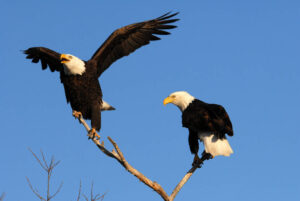by Jessica Johnsrud, education coordinator
February is a time of year when some people offer chocolates, candlelit dinners, flowers, and other gifts to woo their love interest. This is a time of year when love is also in the air for several of our wild neighbors.
 The earliest nesting bird in Wisconsin is the great horned owl. An unpaired male will hoot vigorously, waiting for a female to respond. Once he attracts a willing partner, or if a pair of great horned owls are already established, they will perform hooting duets. Perched high atop a tree or building, the pair will bob their heads and call back and forth to each other. To keep their bond strong, the pair will rub bills and preen (clean) each other. Throughout their courtship, the male will offer the female a fine meal of squirrel, rabbit, mouse or even skunk. Great horned owls do not have a sense of smell, so they are not picky eaters.
The earliest nesting bird in Wisconsin is the great horned owl. An unpaired male will hoot vigorously, waiting for a female to respond. Once he attracts a willing partner, or if a pair of great horned owls are already established, they will perform hooting duets. Perched high atop a tree or building, the pair will bob their heads and call back and forth to each other. To keep their bond strong, the pair will rub bills and preen (clean) each other. Throughout their courtship, the male will offer the female a fine meal of squirrel, rabbit, mouse or even skunk. Great horned owls do not have a sense of smell, so they are not picky eaters.
Speaking of skunks, male skunks leave their winter dens in January and February. They travel one or two miles, but sometimes roam up to five miles in search of mates. Males fight over females, spraying each other in the process. If a female is not interested in a male, she will spray her stinky musk to ward off the hopeful suitor.
Bald eagles may have one of the most dramatic rituals that can be observed in winter. Early in their courtship, the female and male will fly high into the sky, lock talons and then dramatically cartwheel spin as they drop toward the ground, breaking away from each other at the very last minute. They may also chase each other and lock talons to perform aerial rolls. If you’ve been fortunate enough to witness this, it’s quite an acrobatic show!
Rabbits also start looking for mates in February and participate in a practice called cavorting. This often happens under the soft light of dusk and dawn, but occasionally during the day. The male makes the first move, running fast towards the female. She jumps into the air and the male passes underneath. They also chase each other and alternate hopping in a sort of dance. This may continue for up to a half hour and this behavior is thought to help judge the health of prospective mates.
With spring around the corner, other animals will start putting on the charm to attract mates. The frogs will sing, the birds will build nests, and the butterflies will whir around each other. Let the drama unfold!
photo care of U.S. Fish & Wildlife Service
